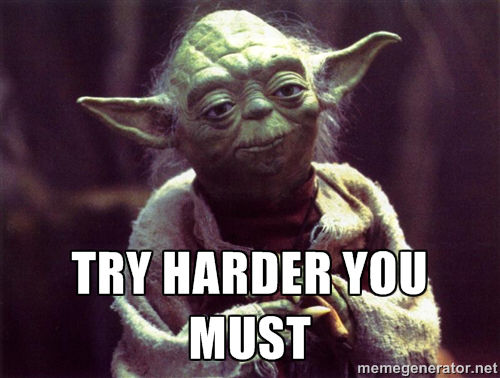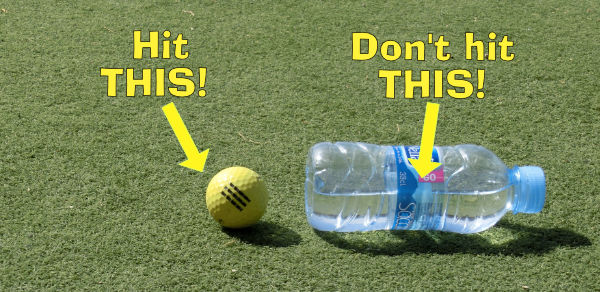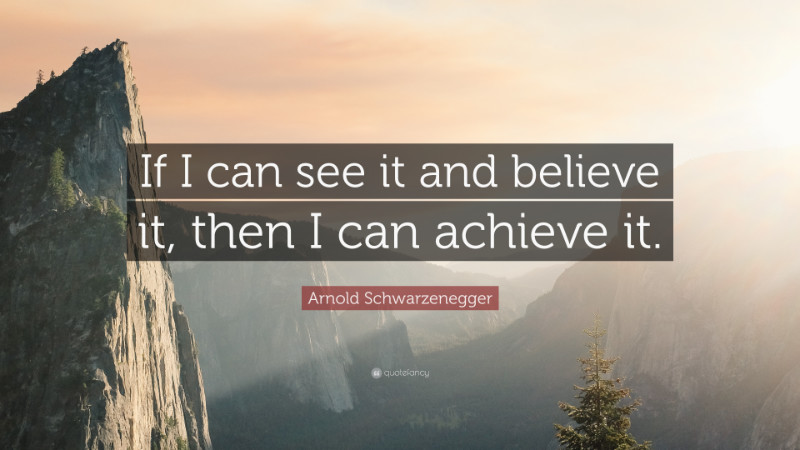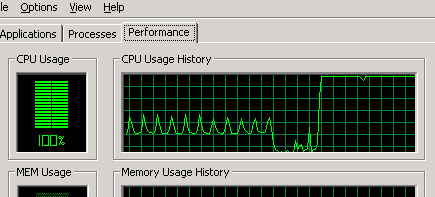While I don’t believe there is one perfect way to swing it, this is not to say that anything and everything goes. There are certainly blends of moves which can increase or decrease your ability to achieve your desired outcome, as well as certain moves which can increase your consistency/ability to achieve your desired result.
I also believe that, as an industry, we put far too much emphasis on the movement pattern, and not enough on the skills/concepts which make a player good at the game. However, with that said, there are times and places where we may want to dive directly into and change a non-functional movement pattern.
Let’s have a look at the top ways to change a movement.
#1 – What’s The Point?
Our brains are the most sophisticated “movement creators” in the world. Set it a goal, such as “Pick this mug of coffee up from that table” and it can coordinate all the moving body parts to do the task. In fact, it can coordinate them in many different ways.
However, this ability is severely compromised when we either:
- Don’t know what the goal of the movement is (or have incorrect goals)
- Don’t receive adequate feedback
If you don’t know the goal of the movement change, it may cause issues. Worse still, you may actually start to set an incorrect goal. This competing concept can be a real roadblock in making a desired swing change.
Lesson: Understand the goal of the change.
#2 – Change The Right Bit Of Code
Your computer keeps crashing when you open up a certain program. You keep fiddling with the code, but to no avail. The actual problem may lie in a different program which is interacting with the other one.
You are essentially fiddling with the wrong bit of code.
This is similar to golf – Sometime you may attempt to change movement patterns. However, the problem may lie elsewhere. For example, a player may be trying their hardest to get some weight shift, but they have a 12 degree left swing direction. But a leftward swing direction puts the low point of the ball so far forwards that the player can’t shift their weight, or they would miss the ball. The player has been working so hard on weight shift, but they have essentially been trying to fix the code in the wrong program.
This is why help from a professional teacher can greatly aid you.
Lesson: Make sure you are changing the right thing.
#3 – Are You Sure?
 You hack into the program and are about to change the code, then your computer asks "Are you sure?". Our subconscious mind acts like this “are you sure” message. It sees any change as a potential threat and puts up a guard against it.
You hack into the program and are about to change the code, then your computer asks "Are you sure?". Our subconscious mind acts like this “are you sure” message. It sees any change as a potential threat and puts up a guard against it.
For this reason, you have to fully commit to the change mentally.
Lesson: Commit 100% to the change, not the result.
#4 – Try Harder
 Golfers always complain of inconsistency, yet that is not always the case. The difference between your best and worst shots resides in the minutiae of impact variables, not making a wildly different movement pattern each time (as you believe).
Golfers always complain of inconsistency, yet that is not always the case. The difference between your best and worst shots resides in the minutiae of impact variables, not making a wildly different movement pattern each time (as you believe).
In fact, as humans beyond the age of 20, we have incredibly stubborn bodies. This means that it requires incredible effort to be able to change it (as opposed to kids who change too easily).
As a result, at least initially, you may have to magnify the feel of a change tenfold in order to get your desired change. This magnification will reduce over time as you go through perceptual adaptation.
Lesson: Increase your effort levels initially during the change.
#5 – You Can Make Mistakes
 Probably the biggest roadblock of all to making a movement change is the fear of hitting a poor shot. Taking the ball away often instantly enables a person to make the movement they wish, but they revert back to old patterns when the ball is re-introduced out of fear of hitting it poor with the new movement.
Probably the biggest roadblock of all to making a movement change is the fear of hitting a poor shot. Taking the ball away often instantly enables a person to make the movement they wish, but they revert back to old patterns when the ball is re-introduced out of fear of hitting it poor with the new movement.
Lesson: Stop letting fear control your movement. Allow yourself to make mistakes in the learning process. It’s ok, no one will remember it, but they might revel at the classy new swing you possess.
#6 – If A=True, Then X
I often set up constraints for my students. These constraints mean that the old movements can’t be performed, and the new movements must arise out of necessity. This is like a computer programmer setting up some IF-THEN-ELSE constructs.
By setting up a constraint, you are forced to shift away from wrong strike pattern.
Lesson: Set up constraints so that the desired technique must arise.
#7 – Disconnect
Our minds/movements are strongly coupled with the target/ball/result. This connection blocks a change in our performance - like a computer program being unable to change when another program is open. The answer? Shut the other program down.
The best thing to do is to separate each element in order to make a change and then gradually link it all back together (uncoupling – re-coupling process). This could be achieved using a driving net, taking away the ball (or using a whiffle ball), or simply mentally disconnecting from the target during initial movement changes.
Lesson: Sometimes we have to train out of context in order to make a desired change. However, be careful to do this in the right amounts and at the right times. 
#8 – Visualize It
One of the greatest helps to a student making a swing change is having a clear mental image of what they are trying to achieve.
Lesson: Close your eyes for a few minutes or seconds. Get a clear image of what you are trying to do. When (and only when) you can see it, stand up and rehearse the motion.
#9 – Limited Processing Power
When we place so much focus on one area of the swing-code, the rest of the pieces can often lose the glue which makes them coordinate together. This is because (just like a computer), our brains have a limited processing capacity.
This is why, often, when we change a “swing-piece”, we start to see a small decline in performance initially. This is nothing to worry about during the initial phases of change.
Lesson: Our swing may become temporarily dysfunctional when we initially make a change. This is ok, we just have to finish the rest of the code. Be patient.
#10 – Start Small
A computer programmer writes one line of code at a time, until a whole program is written. Golfers, on the other hand, will often try to create a brand new swing instantly. To ease into the change, practice the new moves with as simple a task as possible. For example, a player may go through the following levels: Mmake the new moves with practice swings only, then use a foam soccer ball. When you feel certain about your swing (f.e. 7 out of 10 success rate) , move to a tennis ball and subsequently to a teed up ball.
Lesson: Start small, work your way up. Don’t be too egotistical to make things easier initially – Faldo used a tee during swing changes.
 #11 – Prepare
#11 – Prepare
A computer programmer might decide to make a prototype of the end program. Likewise, you should make some preparatory swings before each real swing when making a change.
The best scenario goes like this:
- See what change you need to make.
- Ask more questions to make sure you fully understand.
- Close their eyes and take time to visualize the new moves.
- Rehearse it in slow motion.
- Gradually add speed to it.
- Do at least 10-20 rehearsal swings before they even hit the ball.
- Ask for feedback pertaining to the movement after each ball, before repeating steps 3-7.
Try to understand your movement, but also to "feel it". It is not only about mechanical change.
Lesson: Rehearse the hell out of what you want to do, mentally and physically.
#12 – Periodize
You may wish to improve the code of your computer program, but if you are always spending time on Facebook, this isn’t going to get the job done.
 Similarly, golfers are often seeking the Facebook-style instant gratification of performing with what they have. For example, they might be trying to create better shot performance with their current 60-yard slice. And while you might get to the point of hitting more fairways with this less than desirable technique, you may be limiting your long-term potential.
Similarly, golfers are often seeking the Facebook-style instant gratification of performing with what they have. For example, they might be trying to create better shot performance with their current 60-yard slice. And while you might get to the point of hitting more fairways with this less than desirable technique, you may be limiting your long-term potential.
Lesson: Periodize and maximize change for long term benefits as well as the performance with current variable.
Conclusion
So, quit being a golfer trapped in their old swing-program. Change is tough, but very possible. Through utilizing some of the above (or all of it) you can become the world’s best swing-hacker. While I certainly put a lot more emphasis on correct concepts/awareness and skill building, technical change is a powerful supplement to that. Just make sure you are working with a great teacher so you can be hacking into the right kind of swing-code (as opposed to listening to the advice of your golfing buddies).

